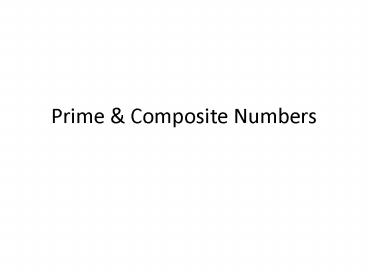Prime - PowerPoint PPT Presentation
1 / 8
Title: Prime
1
Prime Composite Numbers
2
Fun and Games
- Number Theory GONE WILD!
Factors Fall into Families
Multiples Multiply like Rabbits!
3
What am I Learning Today?
- Prime and Composite Numbers
How will I show that I learned it?
Compare and contrast prime and composite
numbers Use divisibility rules to determine a
numbers characteristics
4
Vocabulary
- Composite number A number that is divisible by
more than two numbers. - Prime number A number greater than one that is
only divisible by one and itself.
5
Sieve of Eratosthenes
How its done
Step 1 Circle 2 in blue because it is prime. Now
cross out all the multiples of 2 with that same
color. Step 2 Circle 3 in green because it is
prime. Now cross out every third number with
that same color. Step 3 Circle 5 in red because
it is prime. Now cross out all the numbers that
end in 0 or 5 in that same color. Step 4 Circle
7 in yellow because it is prime. Now cross out
every seventh number with that same color. Step
5 Circle the remaining numbers, EXCEPT
for one, in purple because they are all prime.
A Greek mathematician, who made several
discoveries, including the system of latitude and
longitude. He was the first to calculate the
circumference of the Earth, as well as the
distance to the sun. He invented the Leap Day. He
also proposed a simple algorithm for finding
prime numbers.
6
Sieve of Eratosthenes
7
Paired Discussion
- Turn to a partner and discuss the following
- 1) How can the divisibility rules help you
identify composite numbers? - 2) The Sieve of Eratosthenes didnt include the
number ONE. Is it prime or composite? - 3) Are prime numbers mostly odd or mostly even?
Explain.
8
Credits
- http//en.wikipedia.org/wiki/FileNew_Animation_Si
eve_of_Eratosthenes.gif - http//my.hrw.com Selected slides from
c1_ch04_01.ppt - http//www.knowledgerush.com/kr/encyclopedia/Erato
sthenes/ Picture of Eratosthenes































